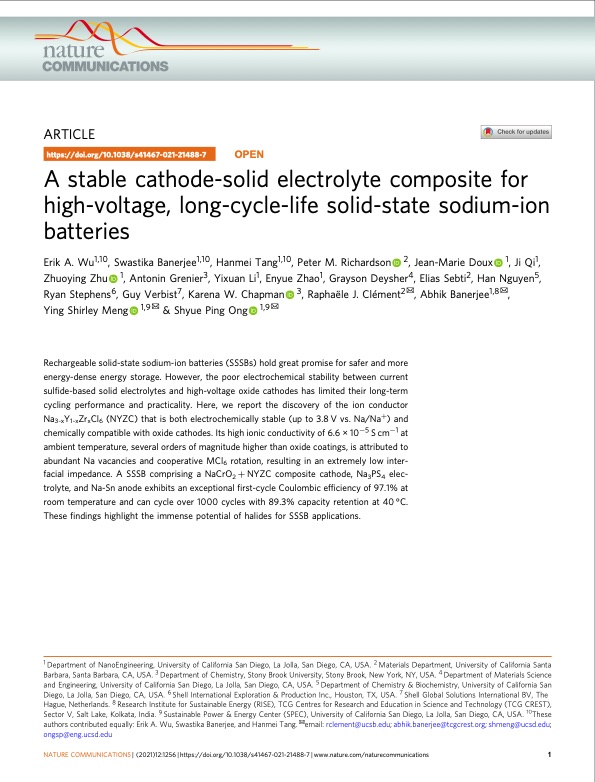
PDF Publication Title:
Text from PDF Page: 001
ARTICLE https://doi.org/10.1038/s41467-021-21488-7 OPEN A stable cathode-solid electrolyte composite for high-voltage, long-cycle-life solid-state sodium-ion batteries Erik A. Wu1,10, Swastika Banerjee1,10, Hanmei Tang1,10, Peter M. Richardson 2, Jean-Marie Doux 1, Ji Qi1, Zhuoying Zhu 1, Antonin Grenier3, Yixuan Li1, Enyue Zhao1, Grayson Deysher4, Elias Sebti2, Han Nguyen5, Ryan Stephens6, Guy Verbist7, Karena W. Chapman 3, Raphaële J. Clément2✉, Abhik Banerjee1,8✉, Ying Shirley Meng 1,9✉ & Shyue Ping Ong 1,9✉ Rechargeable solid-state sodium-ion batteries (SSSBs) hold great promise for safer and more energy-dense energy storage. However, the poor electrochemical stability between current sulfide-based solid electrolytes and high-voltage oxide cathodes has limited their long-term cycling performance and practicality. Here, we report the discovery of the ion conductor Na3-xY1-xZrxCl6 (NYZC) that is both electrochemically stable (up to 3.8 V vs. Na/Na+) and chemically compatible with oxide cathodes. Its high ionic conductivity of 6.6 × 10−5 S cm−1 at ambient temperature, several orders of magnitude higher than oxide coatings, is attributed to abundant Na vacancies and cooperative MCl6 rotation, resulting in an extremely low inter- facial impedance. A SSSB comprising a NaCrO2 + NYZC composite cathode, Na3PS4 elec- trolyte, and Na-Sn anode exhibits an exceptional first-cycle Coulombic efficiency of 97.1% at room temperature and can cycle over 1000 cycles with 89.3% capacity retention at 40 °C. These findings highlight the immense potential of halides for SSSB applications. 1 Department of NanoEngineering, University of California San Diego, La Jolla, San Diego, CA, USA. 2 Materials Department, University of California Santa Barbara, Santa Barbara, CA, USA. 3 Department of Chemistry, Stony Brook University, Stony Brook, New York, NY, USA. 4 Department of Materials Science and Engineering, University of California San Diego, La Jolla, San Diego, CA, USA. 5 Department of Chemistry & Biochemistry, University of California San Diego, La Jolla, San Diego, CA, USA. 6 Shell International Exploration & Production Inc., Houston, TX, USA. 7 Shell Global Solutions International BV, The Hague, Netherlands. 8 Research Institute for Sustainable Energy (RISE), TCG Centres for Research and Education in Science and Technology (TCG CREST), Sector V, Salt Lake, Kolkata, India. 9 Sustainable Power & Energy Center (SPEC), University of California San Diego, La Jolla, San Diego, CA, USA. 10These authors contributed equally: Erik A. Wu, Swastika Banerjee, and Hanmei Tang. ✉email: rclement@ucsb.edu; abhik.banerjee@tcgcrest.org; shmeng@ucsd.edu; ongsp@eng.ucsd.edu NATURE COMMUNICATIONS | (2021)12:1256 | https://doi.org/10.1038/s41467-021-21488-7 | www.nature.com/naturecommunications 1 1234567890():,;PDF Image | cathode-solid electrolyte composite sodium-ion

PDF Search Title:
cathode-solid electrolyte composite sodium-ionOriginal File Name Searched:
s41467-021-21488-7.pdfDIY PDF Search: Google It | Yahoo | Bing
Salgenx Redox Flow Battery Technology: Salt water flow battery technology with low cost and great energy density that can be used for power storage and thermal storage. Let us de-risk your production using our license. Our aqueous flow battery is less cost than Tesla Megapack and available faster. Redox flow battery. No membrane needed like with Vanadium, or Bromine. Salgenx flow battery
| CONTACT TEL: 608-238-6001 Email: greg@salgenx.com | RSS | AMP |